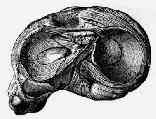 - Discussion:
- Discussion:
- semilunar cartilages are extensions of tibial articulation of knee;
- w/o menisci, tibial articulation is incongruous with the femur;
- microscopic features
- vascular anatomy
- anatomy:
- medial meniscus
- bucket handle meniscus tear
- posterior horn tears of medial meniscus
- lateral meniscus
- discoid meniscus
- ref: A Quantitative Study of the Microstructure and Biochemistry of the Medial Meniscal Horn Attachments
- load bearing function:
- menisci distribute forces throughout underlying articular cartilage, thus minimizing point contact;
- menisci bear 40 to 50% of the total load transmitted across joint in extension and 85% of the compressive load
is transmitted through the menisci at 90 deg of flexion;
- motion characteristics:
- meniscal motion allows maximal congruency during knee flexion and helps to protect the mensici from injury;
- in the study by Vedi V, et al (1999), meniscal movement was studied using a dynamic MRI:
- w/ wt bearing, anterior horn of medial meniscus moved through a mean of 7.1 mm and posterior horn through 3.9 mm, and
there was 3.6 mm of mediolateral radial displacement;
- w/ wt bearing, the anterior horn of the lateral meniscus moves 9.5 mm and the posterior horn moves 5.6 mm, and there was
3.7 mm of radial displacement;
- authors felt that relative immobility of the posterior horn of the medial mensicus may account for its propensity for injury;
- while secondary stabilizer, menisci do impart some stability to normal knee and more important to the ligament deficient knee;
- each is attached at its periphery to capsular ligament on medial or lateral side of joint & at its horns to interarticular area of tibia;
- connecting menisci anteriorly is the transverse ligament.
- menisci help compensate for incongruence of the bones, and they appear to be involved in rotation by moving on the tibia;
- as result of sufficient stress (usually rotary in wt-bearing, flexed knee), either meniscus may be torn w/in itself or from its
peripheral attachment;
- ref: Meniscal movement. An in-vivo study using dynamic MRI.
- MRI Features:
- Precision in the diagnosis of meniscal lesions: a comparison of clinical evaluation, arthrography, and arthroscopy.
- Magnetic resonance imaging of a symptomatic meniscal ossicle.
- Management of Meniscus Tears:
- Meniscal Repairs
- ref: The Effect of Knee Flexion Angle on Neurovascular Safety of All-Inside Lateral Meniscus Repair: A Cadaveric Study
- Menisectomy:
- references:
- Dynamic Contact Mechanics of the Medial Meniscus as a Function of Radial Tear, Repair, and Partial Meniscectomy
- A long-term follow-up study of total meniscectomy in children.
- Partial versus total meniscectomy. A prospective, randomised study with long-term follow-up.
- Arthroscopic treatment of meniscal cysts.
- Lesions of the menisci. Autopsy incidence in adults less than fifty-five years old.
- Total meniscectomy in adolescents. A 40-year follow-up
The knee joint meniscus. A fibrocartilage of some distinction.

